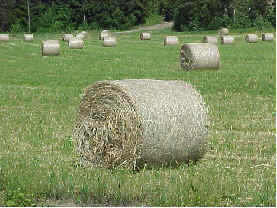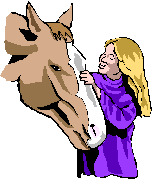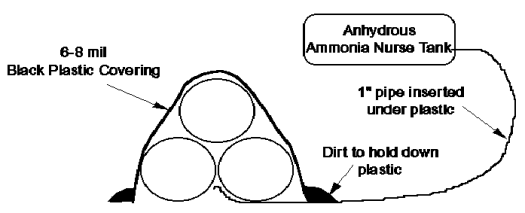

To send a message to an author, click on the author's name at the end of the article.
This Month in Ag Connection | Ag Connection - Other Issues Online
An important question to ask yourself every year is how much hay will I need to get the herd through the winter. The following is a good rule of thumb for determining your winter hay needs.

Start by estimating the hay available or left over. Base your estimate on the weight of several bales. Adjust your estimates for storage and feeding losses, especially if hay is stored outside.
Next, calculate the number of animal units you will be feeding over the winter. Base the number of animal units on 1 unit for a mature 1000 pound animal, ½ unit for yearling cattle, and ¼ unit for calves. Each animal will eat approximately 30 to 40 pounds of average to good quality hay per day on an as fed basis.
Finally multiply each animal unit x days x the amount of hay fed per day.
An example would be as follows (assume 120 days of feeding hay, with the following herd):
| 35 cows | x | 1 | = | 35.0 |
| 10 backgrounding steers | x | ½ | = | 5.0 |
| 15 replacement heifers | x | ½ | = | 7.5 |
| 8 calves | x | ¼ | = | 2.0 |
| 1 bull | x | 1 ½ | = | 1.5 |
| Total | 51.0 animal units |
|---|
To figure total pounds needed multiply 51 animal units x 120 days x 30 pounds of hay per day. This totals 183,600 pounds of hay or 230 bales of hay needed (assuming the bales weigh 800 pounds each). This is only an estimate of hay needed. If it is apparent that feed supplies will be inadequate, begin examining management options and feed alternatives to most efficiently maintain the cattle operation.
(Author: Tim Roberts, Natural Resource Engineering Specialist)
This Month in Ag Connection | Ag Connection - Other Issues Online
Each year more than 100 children are killed and 33,000 seriously injured on farms and ranches in the United States.

Matching farm chores to children's development is an important and sometimes difficult task for parents. Because of the wide variation in children's growth and development and the diversity of agricultural practices, specific recommendations for children's work in agriculture cannot be based on age. Each year many unintentional injuries and child deaths occur because parents and children may mistake physical size and age for ability, and underestimate levels of hazard and risk.
To help parents better evaluate appropriate tasks to give children on the farm, a series of guidelines were developed at the request of farm parents. More than 150 members of the agricultural community from throughout the United States, Canada and Mexico participated in this process.

The North American Guidelines for Children's Agricultural Tasks (NAGCAT) contains 62 guidelines that cover a variety of agricultural tasks focusing on the most common jobs children do on the farm. Recommendations are based on physical, mental and emotional development and the amount of supervision and training. By using these guidelines adults can match a child's physical and mental abilities with the tasks involved in completing different agricultural jobs. Ideally, children and adolescents will gain meaningful work experience with minimal risk of agricultural-related disease or injury.
The guidelines include:
For example, the guideline for milking cows using a pipeline asks such questions as:
The hazard analysis notes such hazards as contact with detergents and sanitizers can irritate skin and that animal movements, kicks and step-ons can cause injury. It then recommends training and supervision.
The 62 guidelines apply to more than prevention of acute traumatic injuries. They include the kind of behaviors that could cause long-term damage, such as hearing loss, breathing problems or a back injury. These are problems that may not happen today or tomorrow, but over time.
The North American Guidelines for Children's Agricultural Tasks (NAGCAT) can be ordered from suppliers of safety equipment and text manuals, and are available in poster form on the Internet at http://www.nagcat.org.
Each poster illustrates a different guideline related to children working in an agricultural setting.
For more information about health and safety issues for children, contact:
(Author: Darin Starr, Ag. Engineering Specialist)
This Month in Ag Connection | Ag Connection - Other Issues Online
Cool season grass hay, baled for the first cutting after June 15, will likely need some supplementation. One option to consider is the ammoniation of low quality hay or wheat straw. Anhydrous ammonia provides a non-protein nitrogen source for mature ruminates while it improves the digestibility.
Anhydrous ammonia is very toxic and extreme care must be used when treating forages. The best results occur when forages contain about 15% moisture. While most producers ammoniate large round bales, ammoniation of square bales will work just as well.

A heavy mil plastic sheet (6-8 mil) is used to cover the stack. To best utilize the plastic cover, large round bales are stacked two bales wide and two bales high (see diagram). To allow the plastic sheet to better cover the ends of the bales, the top row of bales contains one less bale than the ground row. The bales on the top row are then offset by a bale. The edges of the plastic need to be sealed to the ground by placing soil on top of the plastic.
Anhydrous ammonia is injected under the plastic through a 1" plastic pipe. The pipe needs to be placed close to the center of the stack and attached to a fence post to prevent it from moving. Open the valve on the anhydrous tank carefully and apply the anhydrous slowly to keep from blowing the plastic off the stack. Anhydrous ammonia is applied at the rate of sixty pounds per ton.
A roll of 40' x 100' plastic will cover 38 bales. If the bales are 1500 pound bales, the stack will contain 28 tons of forage. If anhydrous ammonia is available for about $.15/pound of nitrogen and a roll of 6 - 8 mil plastic can be purchased for $130.00, the cost of treating a ton of forage will be around $14.00-$16.00.
Ammonia toxicity can occur when cattle are fed ammoniated forage sorghum, hybrid sudan, small grain hay (not straw) and high quality brome and fescue hay. Therefore, avoid treating forages with crude protein content over 7%. The symptoms include extreme excitability, circling, running, convulsions and death. If toxicity should occur, avoid working the livestock and remove the ammoniated forage for several days. A mixture of 50% ammoniated hay and 50% untreated hay should prevent future problems.
Don't give methamphetamine producers an opportunity to access your anhydrous tanks.
(Author: Mark Stewart, Livestock Specialist)
This Month in Ag Connection | Ag Connection - Other Issues Online
The following guidelines should be followed for successful stockpiling of fescue:
See more information on stockpiling in the August 1999 issue of Ag Connections
This Month in Ag Connection | Ag Connection - Other Issues Online
We welcome Tim Roberts to our region. Tim is the Natural Resources Agricultural Engineering Specialist and is headquartered in the Cole County University Extension Center. He comes to Missouri from Tennessee. His first Ag Connections article is the first article of this edition. We are happy to have Tim as a part of our Agriculture Staff in the Central Missouri Region.
This Month in Ag Connection | Ag Connection - Other Issues Online
Publishing Information
Ag Connection is published monthly for Northeast and Central areas of Missouri producers and is supported by the University of Missouri Extension, the Missouri Agricultural Experiment Station, and the MU College of Agriculture, Food and Natural Resources. Managing Editor: Mary Sobba.